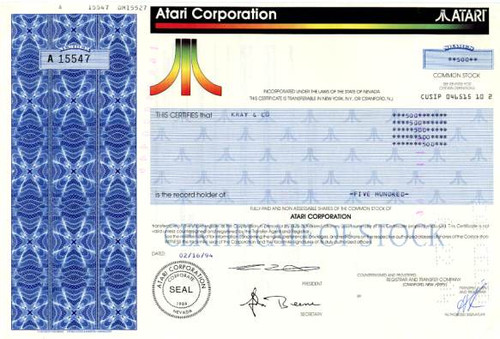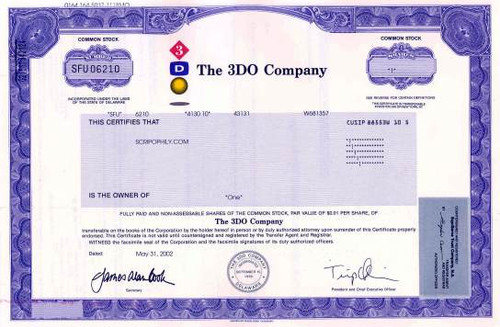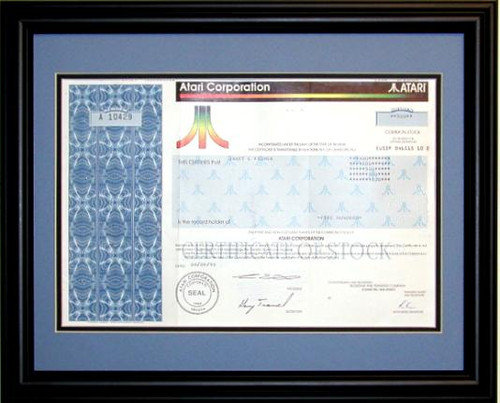Beautifully engraved Certificate (No Pen Marks) from the famous Atari Corporation issued no later than 1992. This historic document was printed by the United States Banknote Corporation and has an ornate block border with a vignette of the famous company logo. This item is has the printed signature of the company's president, Jack Tramiel. These certificates are highly desirable and very collectible. 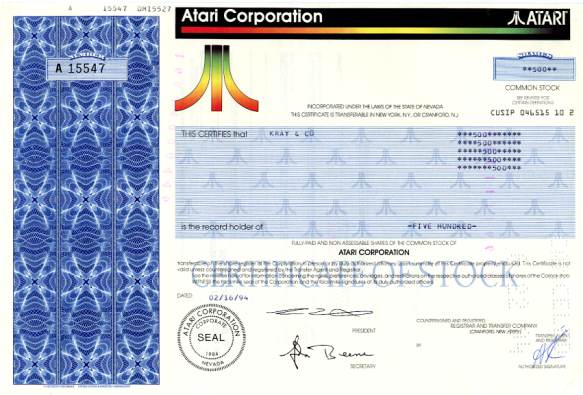
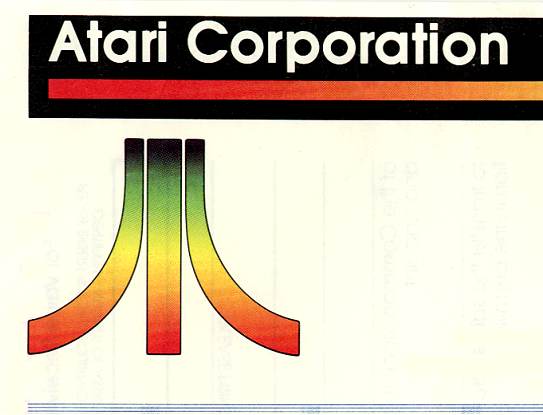
Certificate Vignette In 1953, Jack Tramiel opened a type writer repair shop in the Bronx, New York. Two years later he relocated to Toronto and founded Commodore. A journey from type writers to mechanical adding machines started. In the seventies Commodore went into the electronic pocket calculator business. After surviving the price wars with Texas Instruments, Commodore bought the semiconductor company MOS Technology in the mid-seventies. MOS' senior engineer, Chuck Peddle was working on the 6502 micro processor. A popular 8 bit processor that soon would be used in machines like the Apple II, the Atari 800, the Commodore PET and 64. But first it made its appearance on the KIM-1, a single board computer featuring a hexadecimal display and keyboard. That was Commodore's entrance into the world of micro computers. In 1977, Commodore introduced its first personal computer at the industrial Fair in Hanover. That was the birth of the PET, the Personal Electronic Transactor. A whole family of Commodore business computer was about to follow. Those machines, like the CBM 8032 were successful until the mid eighties. But Jack's vision were computer for the masses. In the early eighties Commodore entered the home computer market with the low cost VIC-20. A friendly computer which got very popular. But that was only the beginning. In 1982 Commodore introduced the Commodore 64, the successor of the VIC-20. With its competitive price it drove Texas Instruments and many others out of the market. The computer was probably built over 20 million times. Commodore rose to a one billion dollar company. At the top of its success Jack Tramiel had a disagreement with the major share holder, Irvin Gould. Jack left the company and a few months later bought Atari. Atari was established in Sunnyvale, California, in 1972 by Nolan Bushnell, an engineer who produced his first video arcade game while tinkering with microcomputers at home. The game, Computer Space, developed in 1971, was a commercial flop, but Bushnell's 2nd arcade game, Pong, became an overwhelming success. Atari sold 10,000 Pong units in 1973 and 150,000 home versions in 1975. Atari's success lured others into the industry, including Magnavox, Bally, Coleco, and RCA. With the added competition, prices dropped and the demand for new games increased. By 1976 the enthusiasm for home video games had waned, and Atari was in need of an infusion of capital. That year Bushnell sold Atari to Warner Communications for $28 million, of which Bushnell received $15 million. Bushnell left Atari 2 years later and went on to start Chuck E. Cheese pizza parlors, among other things. In 1979 Atari's sales picked up because of the popularity of its Video Computer System (introduced in 1977), a cartridge-loaded color graphics console that sold for $200, and the success of its newer, more advanced video arcade games (Asteroids and Missile Command). In 1980 Atari's revenue of $415 million represented 1/3 of Warner's sales. Atari introduced its first line of personal computers in 1980. Initial sales were disappointing, however, and the company lost $10 million on computers in its first year. By 1982 interest in video games had diminished. In 1983 Atari's competitors began dropping out of the market, and Atari lost $533 million. In 1984 Warner sold Atari to Jack Tramiel, former CEO of Commodore, Atari's prime competitor in home computers. Tramiel had Atari in the black in 1986, with net income of $25 million on revenues of $258 million. Contributing to the turnaround were Atari's successive introductions of low-cost personal computers. In 1988 Atari lost $84.8 million largely because of the discontinuation of certain operations of its electronics retail chain, Federated Group (acquired by Atari in 1987). Atari placed Federated up for sale in 1989, and in 1990 the company sold 26 of its California stores to Silo and closed the rest. In 1992 a US district court threw out Atari's $160 million lawsuit charging Nintendo with illegally monopolizing the video game market in the late 1980s. Plummeting sales in the 1990s forced Atari to bite the bullet and restructure its operations, drastically cutting staff and downsizing its international operations. Atari invested heavily in the development of a multimedia game system that would allow Atari to get ahead of its rivals. In 1993 the company launched the Jaguar as the only 64-bit interactive media entertainment system available, and Atari sold around 200,000 units (at $250 each) in its first year on the market. In 1994 Atari agreed to make its library of game patents available to Sega in return for Sega's investment of $90 million in the company. That year Atari teamed up with Virtuality Group of the UK to create virtual reality games for the consumer market. Earnings plummeted in 1995 as Atari cut prices on its Jaguar multimedia interactive entertainment system in an effort to boost sales. In 1996, the company announced that it was starting a new business called Atari Interactive to make and distribute games for personal computers. The video-game pioneer intended to draw heavily on its library of 1980s-vintage video games, such as Asteroids and Pac Man; remaking them with 3-dimensional graphics and stereo sound to capitalize on the latest generation of high-powered PCs. The company merged with JTS Corporation that same year. Following the merger, Atari functioned as a division of JTS until its purchase by Hasbro in March 1998. Steve Jobs and Steve Wozniak .the founders of Apple computer worked for Atari in 1974 The rise and the fall of the pioneer firm of video game industry. Atari History Recap 1971 Nolan Bushnell designed the first commercial arcade video game called "Computer Space", but it was not a big success. 1972 Atari Inc. was founded by Nolan Bushnell from a $250 investment. Pong arcade game becomes a smash hit. 1976 Atari Inc. was sold by Bushnell to Warner Inc. for $28 million. 1980 Atari Inc. posted record sales, $2 billion profits annually. Atari occupied 80 offices in Sunnyvale, California. 1983 Decline of video games and irresponsible spending by Atari Inc. resulted in record losses ($536 million, up to $2 million daily). 1984 Warner divided Atari Inc. to Atari Games (arcade games), and Atari Corporation (Home division). Atari Corp. was sold to Jack Tramiel. 1985 Atari Corp. released Atari ST home computer. 1989 Atari Corp. released Atari Lynx, the world's first color hand-held video game system. 1993 Atari Games became Time-Warner Interactive. 1993 Atari Corp. released Atari Jaguar, the world's first 64-bit home video game system. 1996 Time-Warner Interactive (Atari Games) was sold to WMS. 1996 Atari Corp. merged with JTS Corporation. 1998 Atari Corp. software and hardware rights were sold to Hasbro Inc. for only 5 million dollars.


Certificate Vignette


